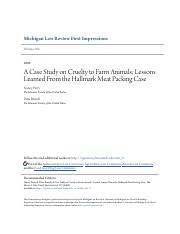In recent years, the spotlight on animal welfare, particularly concerning farm animals, has garnered increased attention. The stark realities of industrial farming practices invite critical examinations and evoke ethical dilemmas that resonate deeply within societal consciousness. This compelling case study sheds light on instances of cruelty to farm animals and aims to illuminate valuable lessons for the future. It urges us to redefine our understanding of animal welfare, shifting our perspectives from mere productivity metrics to holistic ethical considerations.
The convergence of intensive farming methodologies and growing consumer demand has resulted in a systemic neglect of animal rights. Factory farming epitomizes this conflict; animals are often subjected to appalling conditions. Cages are cramped; spaces are confined and devoid of basic necessities. This calamitous environment can lead to not only physical ailments but also psychological distress among these sentient beings. Recognizing the gravity of this matter, we must question our complicity and the implications of our dietary choices.
Historically, agriculture has been synonymous with pastoral imagery—fields of grazing livestock under a sunlit sky. However, modernity has morphed this idyllic conception into something far more dystopian. The efficiency-driven paradigms that dominate contemporary agriculture prioritize profit over the well-being of animals. Under these conditions, studies have documented widespread abuse, where factory farm animals exhibit signs of extreme stress and suffering. The psychological ramifications extend beyond individual animals; entire species are impacted by the prevailing culture of exploitation.
One poignant incident that exemplifies the stark realities faced by farm animals involves the overcrowding in livestock transport vehicles. Reports have unveiled shocking instances where animals are crammed into trucks under appalling conditions, subjected to extreme temperatures and prolonged periods without care. The aftermath of such negligence not only results in physical injuries but also incites mortality during transport. This raises profound ethical questions regarding the responsibility of producers and consumers alike. Could our purchasing decisions inadvertently perpetuate these cycles of suffering?
Another facet worthy of discussion is the life cycle of these animals in agricultural settings. Many have been bred specifically for rapid growth, leading to severe health complications—such as skeletal deformities and organ failure. These hidden faces of animal exploitation reveal a troubling facet of human intervention in natural life cycles. Interestingly, some scholars postulate that by prioritizing genetic traits that bolster meat production, farm animals have been rendered more vulnerable to diseases than ever before. This intersection of agricultural practices and animal health reveals an inconvenient truth about our food systems.
As we delve deeper into the sociocultural implications of animal cruelty, one must also consider the economic factors at play. The agro-industrial complex significantly influences governmental policies. In many cases, legislation fails to protect these vulnerable creatures, often bending to the pressures of corporate interests. This incongruity fosters a narrative that prioritizes economic growth over ethical responsibility. To pivot towards a compassionate future, we must advocate for policy changes that encapsulate animal welfare as a central tenet of agricultural practices. Effective advocacy can lead to systemic transformations, demanding that corporations prioritize humane treatment over mere cost-efficiency.
Amidst these challenges, glimmers of hope emerge as communities and organizations rise to confront these injustices. Activists have employed a plethora of strategies, from grassroots movements to global campaigns aiming to spread awareness. Legal frameworks are evolving too, with more jurisdictions recognizing the inherent rights of animals. This evolution marks a pivotal shift—a nascent acknowledgment that animals are not mere commodities, but beings deserving of dignity and care.
Education serves as a catalyst for change. As consumers become increasingly informed, they wield the power to demand ethical alternatives in their food choices. Awareness can spur consumer advocacy; as more buyers prioritize humane treatment, corporations may be compelled to adapt. Additionally, the surge in plant-based diets illustrates a collective reevaluation of our consumption patterns. This dietary shift showcases a growing willingness to consider the implications of our food choices on animal welfare.
In the realm of technology and innovation, new solutions are emerging, offering alternatives to traditional farming practices. For instance, lab-grown meats and plant-based substitutes present revolutionary options that could diminish or eliminate the need for animal exploitation. These innovations hold immense potential not only for alleviating animal suffering but also for addressing broad environmental concerns intrinsic to industrial livestock farming, such as greenhouse gas emissions and resource depletion.
Moving forward, there exists a profound necessity for collective responsibility amongst stakeholders in agricultural sectors, from producers to consumers. A paradigm shift in our attitudes toward farm animals can contribute significantly to a more humane and sustainable future. By fostering a culture of empathy and responsibility, society can work towards diminishing cruelty against farm animals.
As this case study demonstrates, the intertwining narratives of industry, policy, and consumerism serve to illuminate the pressing need for a comprehensive reevaluation of our relationship with farm animals. By prioritizing ethical considerations in agriculture, we not only honor the lives of these creatures but also bolster our own humanity. Embracing compassionate practices paves the way for a more just and equitable world.
A final reflection: the lessons gleaned from these harrowing realities offer more than mere insights—they inspire action and cultivate hope. Change is indeed possible, yet it relies on the concerted efforts of individuals committed to challenging the norms of exploitation. Each step taken towards compassion is a step closer to creating a world where both humans and animals coexist in mutual respect.









